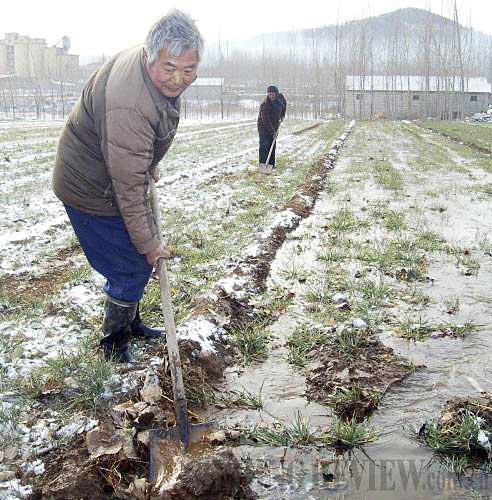|
 |
|
WATER FOR GREENS: Farmers water winter wheat on snow-covered land in Mengzhuang Township of Zaozhuang, Shandong Province. The Chinese Government granted subsidies for winter wheat irrigation to secure grain output (XINHUA) |
The current drought that has depleted water resources in many parts of China is the worst in nearly 60 years. However, the Chinese Government has launched new measures to fight the natural disaster.
The State Council unveiled 10 measures to support grain production at an executive meeting presided over by Premier Wen Jiabao on February 9. The following day, the Chinese premier held a conference to address national grain production, drawing universal concern about China's food security.
Ding Shengjun, a professor at the Academy of State Administration of Grain, said this reflects China's concerns about worldwide price hikes in grain and future increases in grain production.
In early February, the Food and Agriculture Organization of the United Nations (FAO) issued a report warning of grain production decreases in many countries as a result of extreme weather conditions. On February 15, the World Bank said an additional 44 million people may have fallen into dire poverty in low- and middle-income countries due to rising food prices since June 2010.
China has suffered a long spell of drought since October 2010. According to figures from the Ministry of Agriculture (MOA), by February 9, 2011, drought had affected 7.73 million hectares of winter wheat farmland in eight provinces, accounting for 42.4 percent of the total planting area in these provinces.
The State Council's 10 new measures to boost grain production show the government's commitment to addressing this problem and will help reduce the negative influence of natural disasters upon grain production, Ding said.
Ensured food security
Despite droughts and floods, China was still able to produce 546.4 million tons of grain in 2010, an increase of 2.9 percent year on year. While keeping an increase in grain production for seven consecutive years, China is able to maintain a small surplus after achieving grain self-sufficiency.
According to the State Administration of Grain (SAG), at present China has sufficient grain supplies, with a balance kept between demand and supply, and with inventory hovering at a comfortable level. In 2010, local grain and edible oil reserves increased by 26 percent and 208 percent respectively compared with those of 2005.
China has 13 primary grain-producing regions, Heilongjiang, Jilin, Liaoning, Inner Mongolia, Hebei, Henan, Shandong, Jiangsu, Anhui, Jiangxi, Hubei, Hunan and Sichuan, contributing almost 80 percent of the country's total grain output. The grain production in these regions features a large scale and the use of advanced production techniques. The SAG figures show that with vigorous government support, significant progress has been made in creating priority industrial belts of grain crops. So far nine such belts for wheat, rice, corn and soybean production have been set up in China.
Since China is self-sufficient in rice, wheat and corn, according to MOA figures, it is less dependent on the international market for these products. Excluding soybean, the proportion of imported grain among the country's total grain output has been kept below 5 percent.
MOA information released on February 17 showed that after vigorous irrigation efforts and precipitation earlier that month, the spreading drought had been curbed and even eased in a few areas.
"Even if wheat output decreases this year, the reduction won't be that big," said Li Guoxiang, a researcher with the Rural Development Institute of the Chinese Academy of Social Sciences. "China can cope with the reduction by using inventory and won't need to increase its imports of wheat."
Lurking dangers
"For China, which has a population of 1.3 billion, the bowl for our people must be in our own hands," said Ding. "Right now, the mainstay of Chinese food security is not at all solid, and actually it's likely to weaken."
| 